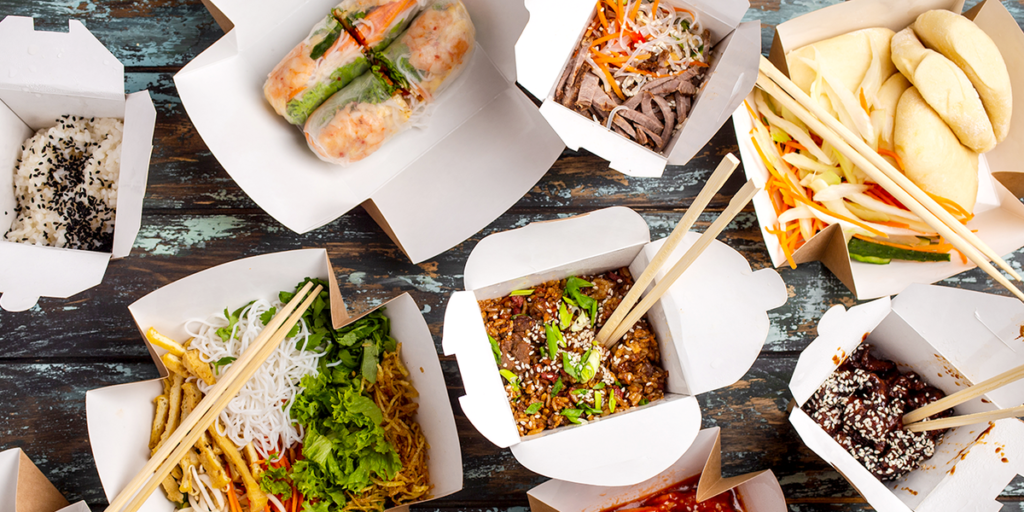When it’s 6 o’clock and everyone is asking what’s for dinner, “Let’s order Chinese food!” may not sound like the most ideal takeout choice if you’re someone who tries to eat on the healthier side (particularly when it comes to American-Chinese food versus traditional). But feel free to get excited, because you can absolutely find nutritious options sprinkled throughout those massive menus.
“Often the issue isn’t that the food itself is unhealthy, it’s that the ratio of carbs to protein and veggies isn’t the most balanced,” says Laura Iu, RD, a certified intuitive eating counselor in New York City. When that ratio is out of sorts, you’re riding on the blood-sugar roller coaster that can take you from feeling super-full to weirdly hungry in an hour’s time, not to mention your energy levels will zoom up and down, too.
DIG IN
But none of this should deter you from enjoying a little takeout every now and again. We asked nutrition experts for some of their healthiest Chinese food dishes, plus their best menu hacks for sneaking in even more nutrients.
1. Moo Goo Gai Pan
This Cantonese dish has it all. While its name translates to mushrooms and sliced chicken, you’ll also score a variety of other beyond-the-basics veggies, like water chestnuts, snow peas and bamboo shoots. Water chestnuts, a popular ingredient, are an aquatic veggie that provides as much heart-healthy potassium per 1/4 cup serving as a small banana. The sauce is also “lighter than many others in Chinese cuisine because it’s made from chicken broth, a little soy sauce, garlic and ginger,” says Iu.
Also, it’s perfectly fine to enjoy white rice, but if you like the taste of brown rice, consider swapping that in for bonus whole grain benefits like extra fiber and vitamins.
2. Steamed Fish and Vegetables
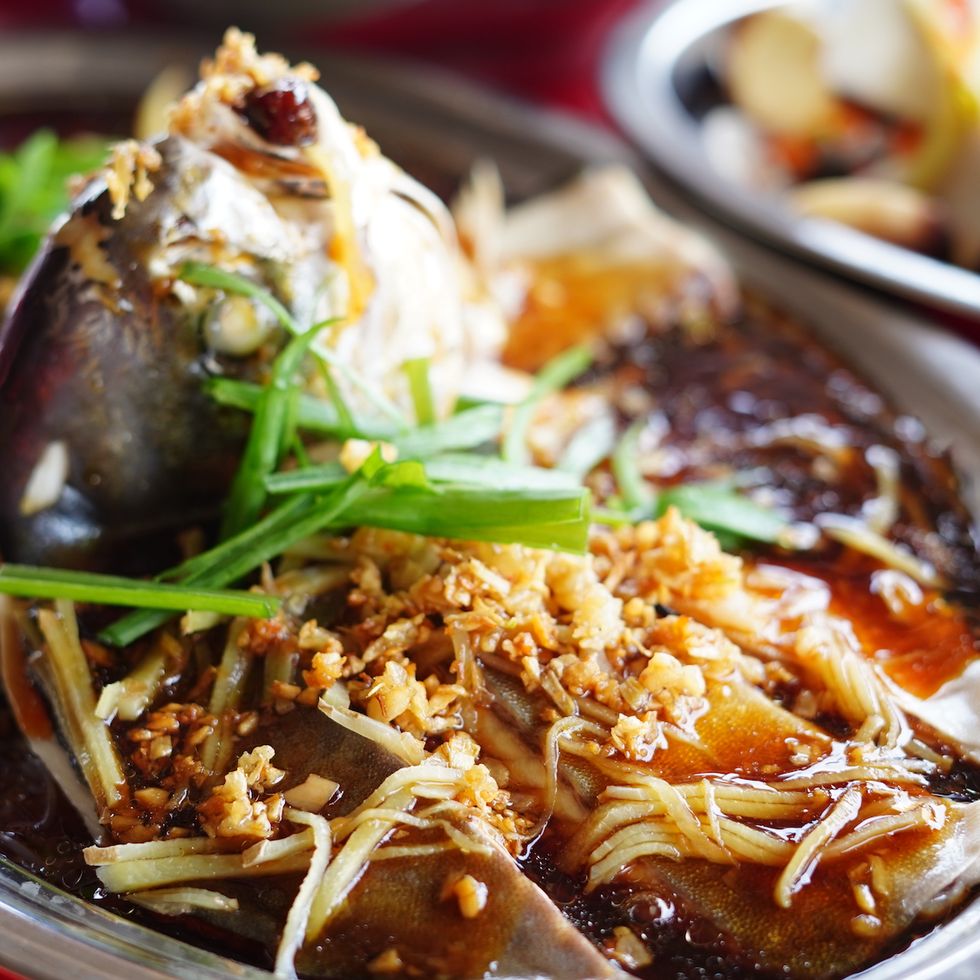 szefei//Getty Images
szefei//Getty Images
Steamed fish and veggies are packed with fiber and protein.
While you may think of steamed dishes as the sad diet food of years’ past, this style of prep is is actually a primary cooking technique that’s culturally authentic to Chinese cuisine, explains Iu. “Choosing a steamed dish is more traditional than choosing General Tso’s Chicken,” Iu adds. Takeout menus tend to offer a mild-tasting variety of protein-rich white fish, such as sole, and it’s paired with mixed vegetables. The veggies add fiber, a key nutrient for digestion and heart health.
If you have the chance to choose or add Chinese eggplant as a veggie, go for it. It has fewer seeds than Western varieties and becomes creamy and tender when stir-fried, plus supplies fiber and anthocyanins (powerful antioxidants).
3. Szechuan Tofu
This vegan szechuan dish is fire — and not just because it’s spicy. Crispy tofu cubes deliver plant-based protein while the sauce is made from anti-inflammatory ingredients such as garlic, ginger and chili peppers. Together they form a heart-healthy combo that your tastebuds will love. At many restaurants, you can even specify the level of spice you’d prefer (if you can handle the heat, kick it up to get even more of the anti-inflammatory capsein from the chilis). Mapo Tofu is a similar version that usually includes ground meat such as pork.
Szechuan tofu tends to be light on veggies, so add a side order of steamed vegetables — a strategy that would be smart to follow for most any entree. “Protein plus plenty of veggies is the recipe for ordering success,” says Jaclyn London, RD, podcast host and author of Dressing on the Side (and Other Diet Myths Debunked).
4. Shrimp with Broccoli in Garlic Sauce
This popular takeout pick also happens to be one of the healthiest. “Shrimp with broccoli in garlic sauce is my go-to Chinese takeout dish,” says London. Low in calories but high in lean protein, shrimp supplies a boatload of immune-supporting selenium. Meanwhile, broccoli contributes fiber and contains compounds that may help fight inflammation and even some cancers.
You may have heard the advice to order sauce on the side when choosing this dish or similar ones such as chicken and broccoli — but unless that’s an option on the menu, don’t. This could come off as culturally insensitive, as ordering something like fettuccine with a side of Alfredo sauce at an Italian restaurant isn’t common, Iu says.
5. Beef and Broccoli
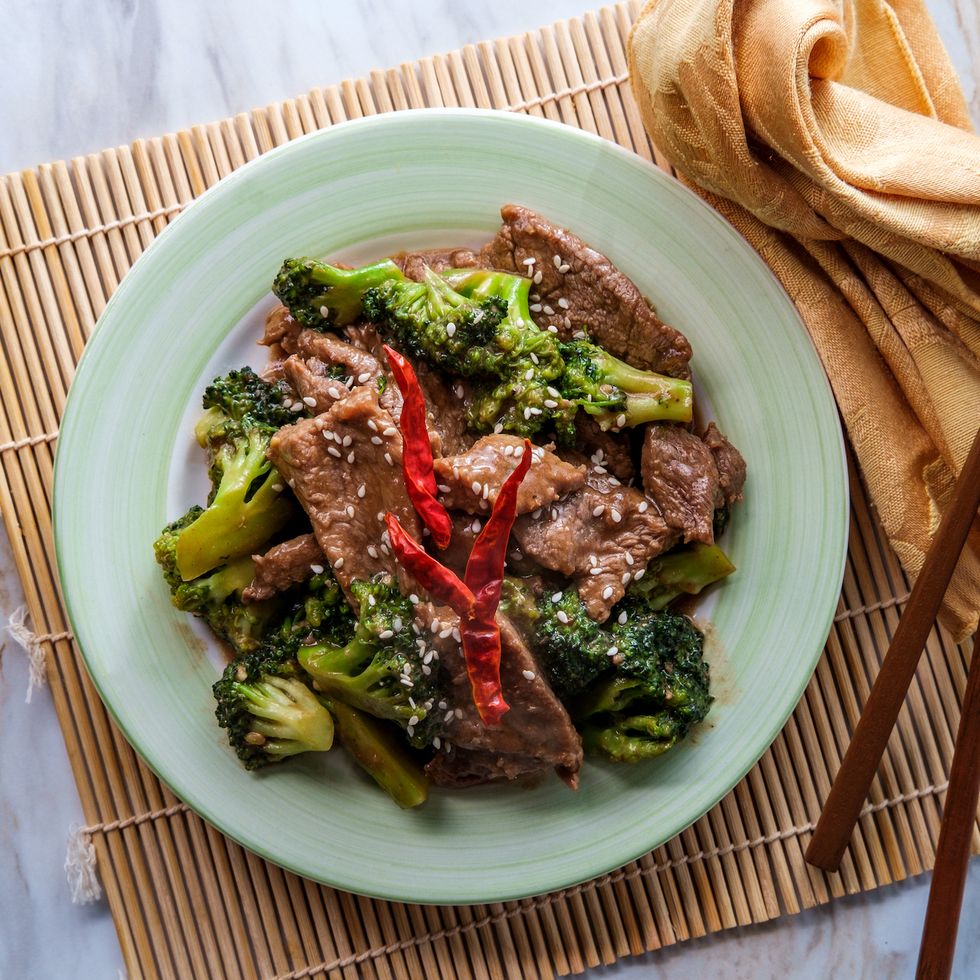 Ezume Images//Getty Images
Ezume Images//Getty Images
Beef and broccoli strikes a great protein-fiber balance.
Nutrition experts have no beef with this dish — steak is a good source of protein and is higher in iron than chicken, so you’ll score more of this essential mineral that helps with maintaining steady energy and oxygen-rich red blood cells. “The dish is usually made with a lean cut of beef, such as flank steak or sirloin and is served with an abundance of broccoli that adds fiber to the meal,” adds London.
Since the broccoli sops up a lot of sauce, you could ask if the chef can make your order using reduced-sodium soy sauce. If that’s not available, just be sure to drink plenty of water with the meal to help your body remove the excess sodium.
6. Chicken with Bok Choy
In the vast chicken section of the menu, zero in on this underrated gem. Thin, tender pieces of protein-rich lean chicken breast are paired with sauteed bok choy, a green leafy veggie also known as Chinese cabbage that delivers vitamins C and A.
If you don’t spot this dish on the menu but notice bok choy as an ingredient in something else, see if you can DIY it. Ask if you can substitute bok choy (instead of, say, string beans) in another chicken and veg dish. Or, you may see bok choy and mushrooms as an option under the vegetarian section on some menus, and if this is the case, you could simply request that they add chicken to that dish.
7. Egg Drop Soup
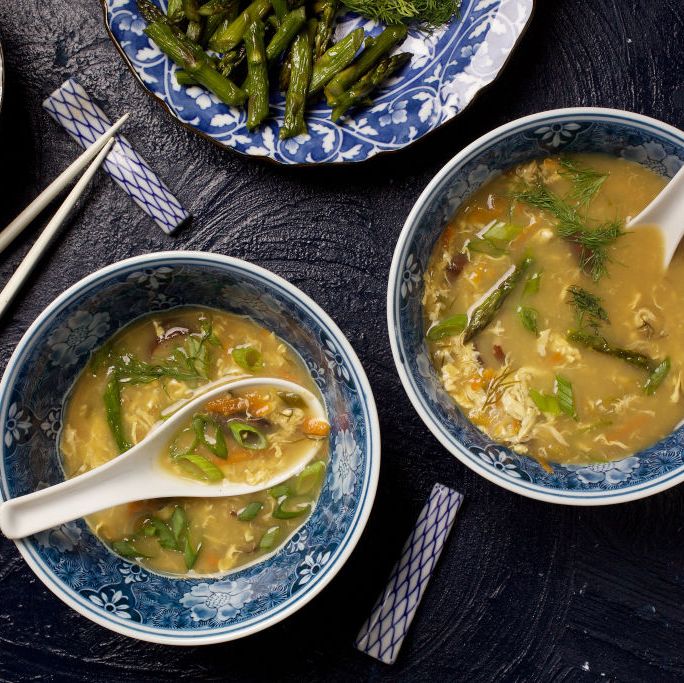 The Washington Post//Getty Images
The Washington Post//Getty Images
Of the soups commonly found on Chinese restaurant menus, egg drop is the healthiest.
Totally starving when you walk into a Chinese restaurant? Order soup as an appetizer, and egg drop is tops. “It’s really made with eggs, so it does offer quite a bit of protein,” says London. You’ll also benefit from anti-inflammatory ingredients such as ginger, scallions and garlic.
Try to resist eating your soup’s complimentary fried noodles — the might be delicious but they are deep-fried (and often ultra-processed), which means they contain unhealthy fats and other not-so-healthy stuff. “If you’re in the mood for noodles, it’s healthier to just order lo mein or chow fun as part of your meal,” says London.
8. Spring Rolls
When it comes to healthy choices, the appetizer selection at many Chinese restaurants is mostly a flop because it’s packed with fried items. “You’ll find far more gems in the entrees than the apps,” says London. One bright spot: Spring rolls. They’re a healthier alternative to egg rolls because they’re usually made with a light rice paper wrapper and more veggies.
Share the order of spring rolls with your dining companions so you have more room for the healthier entrees, or save half and pack them up with the rest of your leftovers.
9. Cucumber Salad
If you see this dish on the appetizer or sides portion of the menu, go ahead and order it as a starter. Compared to fried apps, sliced cukes tossed in a dressing made with vinegar, soy sauce, garlic and chili flakes is a refreshing and nutritious alternative. “This salad offers a flavorful way of promoting hydration, digestive health and immune function,” says Iu.
If this dish is becoming one of your favorites, use your Chinese food craving for good by trying other types of cucumber salad recipes at home — you may find new healthy dishes to add to your rotation, and kids who don’t like a lettuce salad might just discover that they enjoy a crunchy, juicy cucumber one instead.
10. Steamed Dumplings
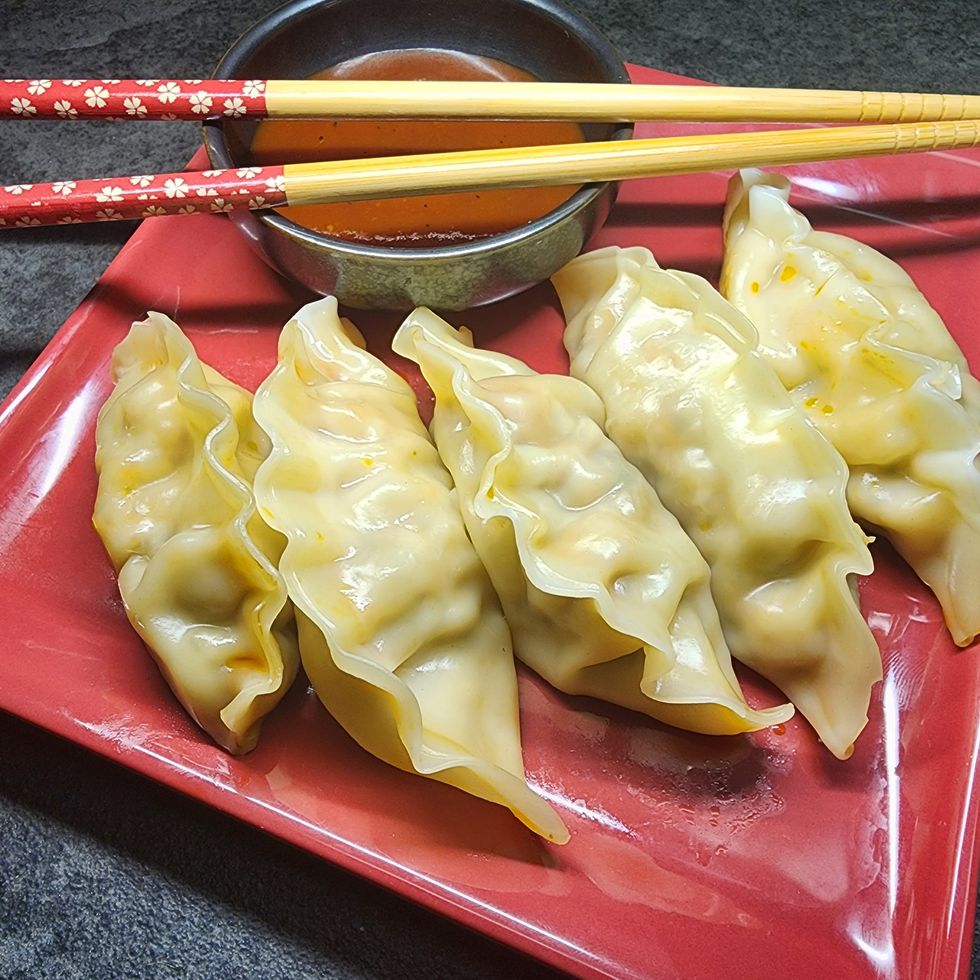 NurPhoto//Getty Images
NurPhoto//Getty Images
Steamed, rather than fried, dumplings are one of the healthier appetizers on Chinese menus.
Chinese restaurants usually offer a choice between pan-fried and steamed dumplings — and often you can select the filling, too. Here’s a good rule of thumb: Opt for steamed over fried, and go with the veggie or shrimp if you’re looking for the lightest filling option, and if ordering a meat filling, choose ones that specify a specific protein (such as pork or chicken) versus just “meat.”
Dumplings are the perfect dish to build a meal around when you’re just looking for a light bite. In this case, order a protein filling and pair your dumplings with a side of veggies.
11. Lo Mein of Chow Fun with Veggies or Protein
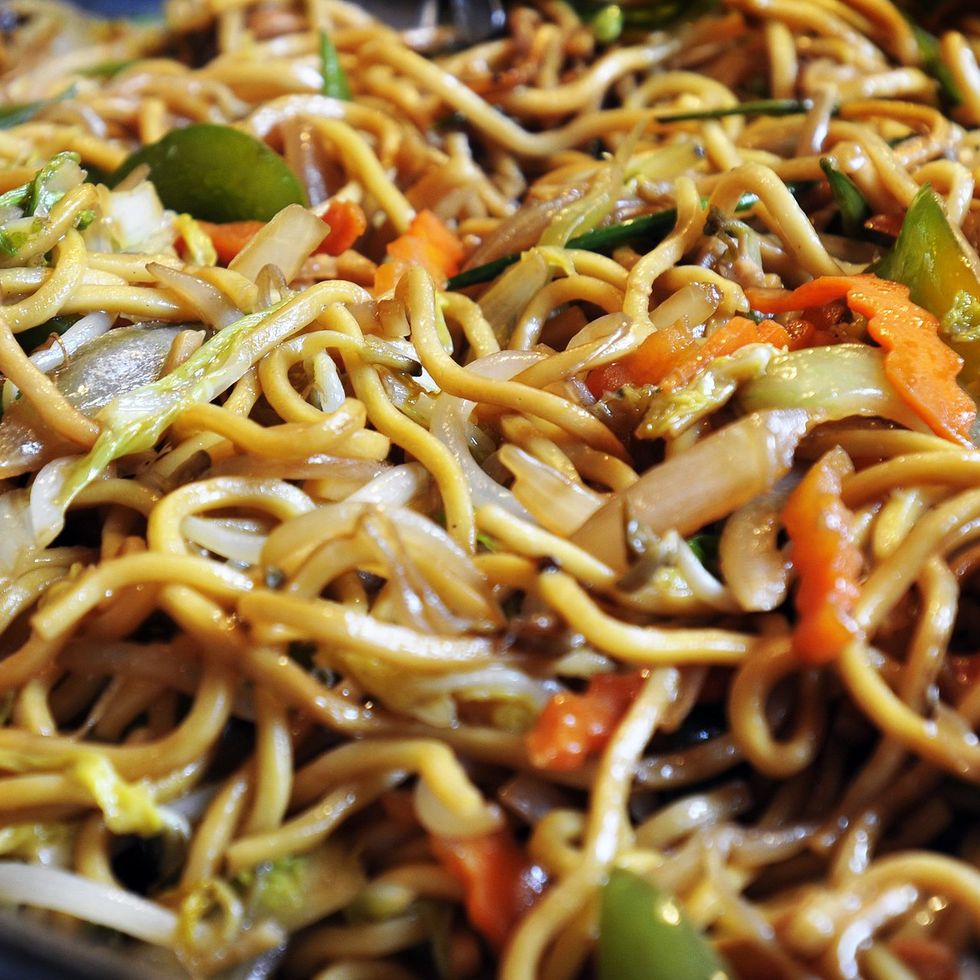 Portland Press Herald//Getty Images
Portland Press Herald//Getty Images
Add some protein to veggie lo mein for a more balanced dish.
When a noodle craving hits, London approves of honoring it. After all, both of these noodle dishes contain vegetables and protein to provide nourishing satisfaction. To boost the nutrition of lo mein, you’ve got two options: Order it with a protein source (like chicken or pork) and mix in an extra side of veggies, or follow Iu’s lead and go for veggie lo mein with a protein-based entree (her go-to is honey walnut shrimp).
Satisfy any food craving (yes, even the less-than-healthy ones!) by eating family-style. That means you order a few better-for-you dishes, plus one delicious, less-healthy pick — that way, everyone can enjoy a few bites of everything and a variety of flavors.
12. White or Brown Rice
Surprise, nutrition experts say that you can pick your fave. “The nutrient density of white and brown rice is pretty similar so unless you feel like you’re not getting enough whole grains, it’s fine to opt for either,” says London. While rice helps balance veggie- or protein-heavy dishes, she cautions not to fill up on it. “The other foods on your plate have so much more flavor,” she says.
READ MORE
If you know how to use chopsticks, grab a pair from your kitchen or request them in your takeout order. In one small study, participants had a lower blood sugar spike when they ate white rice from chopsticks rather than using a spoon, likely because it slowed down their consumption.
The former senior editor at Parents who started the brand’s awards programs, Karen Cicero is a seasoned journalist who specializes in travel, book, lifestyle and food coverage.Cicero has visited almost every state with her family (look out Wyoming, she’s coming for you next!) She recently presented at several travel industry conferences, including PRSA and the Mid-Atlantic Tourism Alliance. A mom who goes overboard for all the holidays, Cicero lives in the Christmas city itself: Bethlehem, Pennsylvania.

Valerie Agyeman (she/her) is a women’s health dietitian and the host of the Flourish Heights podcast, where she produces science-driven content covering overlooked nutrition, wellness and women’s health topics. She has over 10 years of nutrition communications, corporate wellness and clinical nutrition experience. Valerie is a trusted expert and regularly appears on networks including ABC’s Good Morning Washington, and she is a contributing expert to publications like Women’s Health, The Thirty and Shape.

